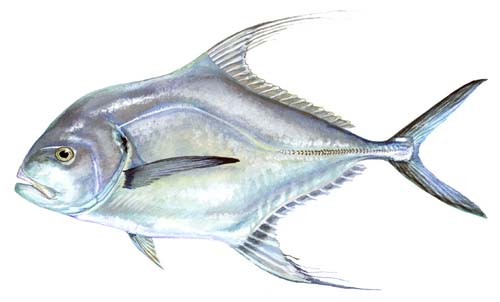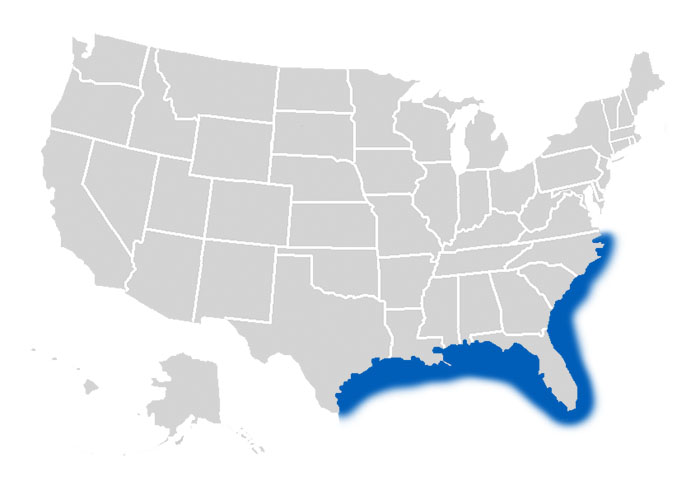African Pompano is a delicious game fish that makes excellent table fare. Pompano can be caught fishing live bait and jigs in middle to the bottom water column around reefs, wrecks and other structures. Peak fishing season for African Pompano is from November to February.

Habitat: Bay, Ocean, Coastal Waters
How to identify African Pompano
The main difference between African Pompano and other Alectis genus is the number of gill rakers located on the first branchial arch. African Pompanos usually have from four to six long threads in the front section of the second dorsal and anal fins.
At an early age, the first of these two threads is often four times longer than the fish itself. As the fish grows, these threads tend to disappear or disintegrate. The short and thick body of the fish evolves as she matures; becoming longer and leaner.
In young Afrian Pompano fish the front dorsal ridge’s spine isn’t that obvious, but it is noticeable. In both young and adult African Pompano the body is well compressed, and the lateral line extends evenly over the pectoral ridges. The color of their body is between light blue and green, complimented by a pearly shine.
Where to catch African Pompano
Anglers can find African Pompano in coastal waters from from New Jersey south around the coasts of Florida and into the Gulf of Mexico.
African Pompano is one game fish species that loves structure. They can be caught along shoreline shallows and reefs at depth of 30 feet or around wrecks and structure as deep as 300 feet. They are most commonly found in temperature ranging from 65-80 degrees Farenheit. In addition to the Atlantics coast of the United States, African Pompano are also found in the coastal waters of Africa, Asia and Australia.
If you want to target African Pompano specifically, fishing shallow wrecks during the winter time provides anglers the best chance of targeting this fish.

The following are additional habitats where you’re likely to catch African Pompano:
- Reefs, Wrecks and Shoals
- Baitfish Schools
- Estuaries
- Channel Entrances
- Coastal Waters
- Jetties and Breakers
- Man-made Structures
- Piers, Docks and Pilings
How to catch African Pompano
African Pompano are often caught unintentionally while fisherman are fishing for other fish species. Trying to target pompano specifically is challenging. Pompano are often found in schools, so multiple hookups can be useful if you’re staying in one area to fish. You best chance of catching African Pompano is around wrecks, reefs and structure found in shallow coastal waters. When fishing any structure, live chumming can be very effective.
We recommend covering the entire water column when targeting African Pompano and using spinning tackle when reef fishing. These fish are know to be leader shy so it’s helpful to avoid leader line over 50lb fluorocarbon. Always fish using multiple hookups and we highly recommend casting behind any Pompano you hook as it gets closer to the boat. It is very common to have or more Pompano following the one you hooked. And always have your pitch rod ready.
The following are additional fishing methods and techniques that can work for catching African Pompano:
- Bait Casting
- Bottom Bouncer
- Drift Fishing
- Fly Fishing
- Saltwater Jigging
- Saltwater Trolling
- Spinning
- Still Fishing
- Surf Casting
Best Lures, Bait & Tackle to catch African Pompano
African Pompano will fall for small bait that is either dead or alive. They can be caught with lures, jigs, and even feathers. They are an ideal fish for individuals who prefer fishing with light equipment.
Fisherman who target pompanos, will find them near offshore wrecks, mostly using live baits and jigs. Using the live bait combined with spinner gear is a more challenging approach, but it can draw the pompano to the surface.
When targeting Pompano in wrecks or reefs in shallower waters, live pilchards or cigar minnows prove very effective. Live pilchards and minnows should be fished on one ounce jig head or with an inline sinker for maximum performance.
The following are fishing lures, bait and tackle that can be used to catch African Pompano:



